Showing Spotlights 1713 - 1720 of 2781 in category All (newest first):
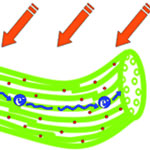 There is an increasing interest in flexible solar cells and researchers have been investigating weavable fiber solar cells based on metal wires, glass fibers, or polymer fibers. Unfortunately, the low efficiencies of these fiber-based solar cells greatly limit their promising applications. In order to improve these efficiencies, scientists are exploring various nanomaterials to improve charge separation and transport in these fiber-based photovoltaic devices. One recent promising result has been demonstrated by a research team in China who have developed a novel solar cell from flexible, light-weight, ultrastrong, and semiconductive carbon nanotube fiber. The high alignment of building nanotubes in the fiber allows charges to separate and transport along the fibers efficiently, which provides a fiber solar cell with high performance.
There is an increasing interest in flexible solar cells and researchers have been investigating weavable fiber solar cells based on metal wires, glass fibers, or polymer fibers. Unfortunately, the low efficiencies of these fiber-based solar cells greatly limit their promising applications. In order to improve these efficiencies, scientists are exploring various nanomaterials to improve charge separation and transport in these fiber-based photovoltaic devices. One recent promising result has been demonstrated by a research team in China who have developed a novel solar cell from flexible, light-weight, ultrastrong, and semiconductive carbon nanotube fiber. The high alignment of building nanotubes in the fiber allows charges to separate and transport along the fibers efficiently, which provides a fiber solar cell with high performance.
Feb 1st, 2011
 A caustic is the envelope of light rays reflected or refracted by a curved surface or object, or the projection of that envelope of rays on another surface. A familiar example of optical caustics is the bright line seen in a coffee cup on a bright sunny day. Here the caustic is formed by the envelope of the light rays reflected by the curved surface of the coffee cup. Caustics are formed in an anisotropic media because the direction of the group velocity and the phase velocity or the wave vector does not coincide. New theoretical work shows the existence of spin wave caustics in nanoscale ferrites, ferromagnetic and antiferromagnetic materials. Based on their theoretical results, the researchers have proposed a new device called a high frequency 'router'.
A caustic is the envelope of light rays reflected or refracted by a curved surface or object, or the projection of that envelope of rays on another surface. A familiar example of optical caustics is the bright line seen in a coffee cup on a bright sunny day. Here the caustic is formed by the envelope of the light rays reflected by the curved surface of the coffee cup. Caustics are formed in an anisotropic media because the direction of the group velocity and the phase velocity or the wave vector does not coincide. New theoretical work shows the existence of spin wave caustics in nanoscale ferrites, ferromagnetic and antiferromagnetic materials. Based on their theoretical results, the researchers have proposed a new device called a high frequency 'router'.
Jan 31st, 2011
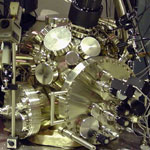 Graphene is a very interesting nanomaterial with potential for applications in many different fields including nanoelectronics. However, the properties of graphene can vary broadly and depend sensitively on its integration in device structures and the details of its interaction with other materials, such as underlying substrates or gate dielectrics. Unlike other semiconductor electronic devices, where the active layer is buried below the surface and where microscopic details of transport cannot be directly examined, graphene is exposed at a surface and can be directly examined on the atomic scale using scanning tunneling microscopy (STM) and scanning tunneling spectroscopy (STS). New work now provides microscopic details of graphene interaction with a substrate in the most common device structure used so far.
Graphene is a very interesting nanomaterial with potential for applications in many different fields including nanoelectronics. However, the properties of graphene can vary broadly and depend sensitively on its integration in device structures and the details of its interaction with other materials, such as underlying substrates or gate dielectrics. Unlike other semiconductor electronic devices, where the active layer is buried below the surface and where microscopic details of transport cannot be directly examined, graphene is exposed at a surface and can be directly examined on the atomic scale using scanning tunneling microscopy (STM) and scanning tunneling spectroscopy (STS). New work now provides microscopic details of graphene interaction with a substrate in the most common device structure used so far.
Jan 27th, 2011
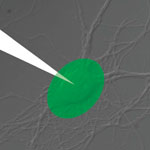 One area of nanobiotechnology that will have a massive impact on improving the live of disabled people lies at the interface (literally) between artificial functional materials and living neuronal tissues. Neuroprosthetics is an area of neuroscience that uses artificial microdevices to replace the function of impaired nervous systems or sensory organs. Different biomedical devices implanted in the central nervous system, so-called neural interfaces, already have been developed to control motor disorders or to translate willful brain processes into specific actions by the control of external devices. One are that has been quite challenging is the communication between biological tissues and artificial sensors - something that is key in building artificial retinas, for instance. Researchers in Italy have now reported the functional interfacing of an organic semiconductor with a network of cultured primary neurons.
One area of nanobiotechnology that will have a massive impact on improving the live of disabled people lies at the interface (literally) between artificial functional materials and living neuronal tissues. Neuroprosthetics is an area of neuroscience that uses artificial microdevices to replace the function of impaired nervous systems or sensory organs. Different biomedical devices implanted in the central nervous system, so-called neural interfaces, already have been developed to control motor disorders or to translate willful brain processes into specific actions by the control of external devices. One are that has been quite challenging is the communication between biological tissues and artificial sensors - something that is key in building artificial retinas, for instance. Researchers in Italy have now reported the functional interfacing of an organic semiconductor with a network of cultured primary neurons.
Jan 26th, 2011
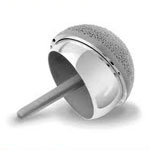 Imagine intelligent medical implants that can continuously monitor their condition inside the body and autonomously respond to changes such as infection by releasing anti-inflammatory agents. Thanks to nanotechnology, medical research is moving quickly towards this goal. A new study shows that the use of polypyrrole films as electrically controlled drug release devices on implant surfaces can potentially improve bone implants. By electrodepositing antibiotics or anti-inflammatory drugs in a polymer coating on medical devices, researchers demonstrate that such drugs can be released from polypyrrole on demand - by applying a voltage - and control cellular behavior important for orthopedic applications, i.e. inhibit inflammation and kill bacteria.
Imagine intelligent medical implants that can continuously monitor their condition inside the body and autonomously respond to changes such as infection by releasing anti-inflammatory agents. Thanks to nanotechnology, medical research is moving quickly towards this goal. A new study shows that the use of polypyrrole films as electrically controlled drug release devices on implant surfaces can potentially improve bone implants. By electrodepositing antibiotics or anti-inflammatory drugs in a polymer coating on medical devices, researchers demonstrate that such drugs can be released from polypyrrole on demand - by applying a voltage - and control cellular behavior important for orthopedic applications, i.e. inhibit inflammation and kill bacteria.
Jan 25th, 2011
 Patterns of news coverage on nanotechnology are developing in ways that mirror issue cycles for previous technologies, including agricultural biotechnology. In particular, early coverage of nanotechnology was dominated by a general optimism about the scientific potential and economic impacts of this new technology. This is in part related to the fact that a sizeable proportion of nanotechnology news coverage - at least in newspapers - continues to be provided by a handful of science journalists and business writers. This is an initial draft of an article that what will eventually become a chapter on public attitudes toward nanotechnology in a new book on risk communication and public perception of nanotechnology. It's meant to be a current update and comprehensive overview of what we know (and don't know) at this point.
Patterns of news coverage on nanotechnology are developing in ways that mirror issue cycles for previous technologies, including agricultural biotechnology. In particular, early coverage of nanotechnology was dominated by a general optimism about the scientific potential and economic impacts of this new technology. This is in part related to the fact that a sizeable proportion of nanotechnology news coverage - at least in newspapers - continues to be provided by a handful of science journalists and business writers. This is an initial draft of an article that what will eventually become a chapter on public attitudes toward nanotechnology in a new book on risk communication and public perception of nanotechnology. It's meant to be a current update and comprehensive overview of what we know (and don't know) at this point.
Jan 24th, 2011
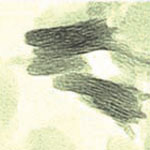 Traditional anode materials for lithium-ion batteries, like graphite, have a fairly low storage capacity and release rate, so finding alternatives is key to making batteries that last longer and produce more power. Titanium dioxide is regarded as one of the ideal candidates for high-rate anode materials, owing not only to its structural characteristics and special surface activity, but also to its low cost, safety, and relatively low environmental impact. Researchers in Singapore have developed a facile system to fabricate sandwich-like carbon-supported stacked titanium dioxide nanosheets, in which carbon pillars create open channels for fast lithium ion diffusion and the ultrathin framework renders the storage of lithium almost exclusively on the surface. This work provides a new route to design the electrode materials for quick-charging lithium ion batteries.
Traditional anode materials for lithium-ion batteries, like graphite, have a fairly low storage capacity and release rate, so finding alternatives is key to making batteries that last longer and produce more power. Titanium dioxide is regarded as one of the ideal candidates for high-rate anode materials, owing not only to its structural characteristics and special surface activity, but also to its low cost, safety, and relatively low environmental impact. Researchers in Singapore have developed a facile system to fabricate sandwich-like carbon-supported stacked titanium dioxide nanosheets, in which carbon pillars create open channels for fast lithium ion diffusion and the ultrathin framework renders the storage of lithium almost exclusively on the surface. This work provides a new route to design the electrode materials for quick-charging lithium ion batteries.
Jan 21st, 2011
 Thermoelectric materials therefore hold great promise for turning waste heat back into useful power and are touted for use in hybrid cars, new and efficient refrigerators, and other cooling or heating applications. Thermoelectric devices are energy converters - they are based on the fact that when certain materials are heated, they generate a significant electrical voltage; conversely, when a voltage is applied to them, they become hotter on one side, and colder on the other. But they have one big drawback: they are very inefficient. Efficient thermoelectric materials need to be very good at conducting electricity, but not heat - and that's the problem; these materials are not efficient enough to be practical. In most materials, electrical and thermal conductivity go hand in hand. So researchers have to find ways of boosting the performance of thermoelectric materials by separating the two properties.
Thermoelectric materials therefore hold great promise for turning waste heat back into useful power and are touted for use in hybrid cars, new and efficient refrigerators, and other cooling or heating applications. Thermoelectric devices are energy converters - they are based on the fact that when certain materials are heated, they generate a significant electrical voltage; conversely, when a voltage is applied to them, they become hotter on one side, and colder on the other. But they have one big drawback: they are very inefficient. Efficient thermoelectric materials need to be very good at conducting electricity, but not heat - and that's the problem; these materials are not efficient enough to be practical. In most materials, electrical and thermal conductivity go hand in hand. So researchers have to find ways of boosting the performance of thermoelectric materials by separating the two properties.
Jan 20th, 2011
 There is an increasing interest in flexible solar cells and researchers have been investigating weavable fiber solar cells based on metal wires, glass fibers, or polymer fibers. Unfortunately, the low efficiencies of these fiber-based solar cells greatly limit their promising applications. In order to improve these efficiencies, scientists are exploring various nanomaterials to improve charge separation and transport in these fiber-based photovoltaic devices. One recent promising result has been demonstrated by a research team in China who have developed a novel solar cell from flexible, light-weight, ultrastrong, and semiconductive carbon nanotube fiber. The high alignment of building nanotubes in the fiber allows charges to separate and transport along the fibers efficiently, which provides a fiber solar cell with high performance.
There is an increasing interest in flexible solar cells and researchers have been investigating weavable fiber solar cells based on metal wires, glass fibers, or polymer fibers. Unfortunately, the low efficiencies of these fiber-based solar cells greatly limit their promising applications. In order to improve these efficiencies, scientists are exploring various nanomaterials to improve charge separation and transport in these fiber-based photovoltaic devices. One recent promising result has been demonstrated by a research team in China who have developed a novel solar cell from flexible, light-weight, ultrastrong, and semiconductive carbon nanotube fiber. The high alignment of building nanotubes in the fiber allows charges to separate and transport along the fibers efficiently, which provides a fiber solar cell with high performance.
 Subscribe to our Nanotechnology Spotlight feed
Subscribe to our Nanotechnology Spotlight feed





